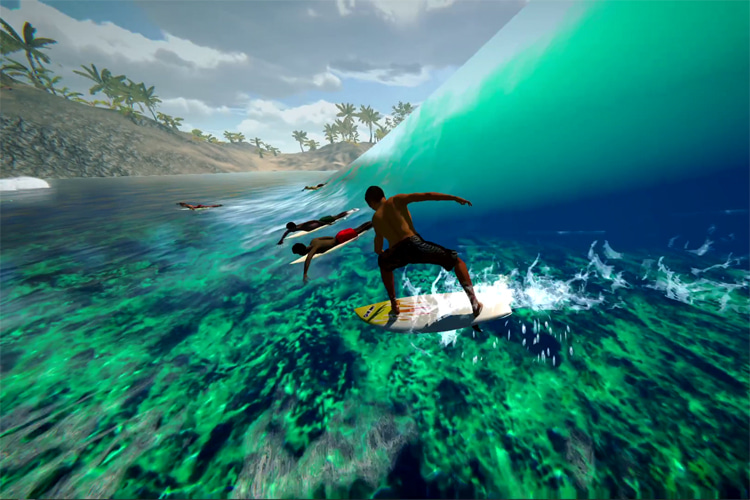My long journey to develop an open-world surfing video game

I’m now making a surfing video game called “Surfers Code,” but I probably shouldn’t be.
I’m 57 years old and have surfed since I started high school at Newbury Park in Southern California near Ventura.
I didn’t know that my dad didn’t know how to swim when I started surfing, or maybe I would have been encouraged to start surfing when I was younger.
My mom took us down to Ventura Harbor as kids, where we would boogie board until we turned purple, but then we discovered wetsuits, got some old surfboards, and found out how much more fun standing up was.
Since then, I have been obsessed with surfing as much as I am now obsessed with this crazy video game.
I was not so much into video games, but I played some games on consoles when I moved to San Diego during and after college.
After several trips to live and work in Kenya, El Salvador, and Guatemala, I eventually ended up living and working in Taiwan.
Everyone there had a cell phone way before it was popular to have cell phones in the US, so I started looking into making a cell phone game for Taiwanese to learn English.
I moved back to California, so I scrapped the learning English idea, looked into other possibilities, and decided on a surfing game.

Where to Start
There weren’t any very good recent surfing games.
I had the background and experience to make a surfing game that appealed to surfers, so I decided to make a tropical chill surfing game modeled after the tropical environments where I lived and surfed.
I soon learned that some limiting technical issues are involved in developing a surfing game, making it more difficult than most other games.
For one thing, making waves requires a lot of processing power or massive shortcuts and oversimplifications to achieve a variety of waves and allow interaction with the surfer.
The shortcuts I came up with made the interaction with the waves horrible and did not provide a realistic or even reasonable experience that simulated surfing.
I scrapped the mobile idea since even making waves for a decent desktop computer was pretty technically difficult, and I tried a few ways of making waves.
I tried rigging a wave like a character would be set up in a way where moving the underlying bones makes the surface of the wave move.
I tried moving the points of a plane to predetermined locations the same way that character faces are moved, but not until I tried moving the vertices in 3D using an equation did something variable and performant emerge.
I guess an engineering degree can come in handy in some situations.
I found a pulse wave equation and how to apply the equation to the vertices of a mesh over time.
With the help of Math Labs, I came up with an equation that could be used to make waves that vary in steepness and side speed, vary the size of the shoulder of the wave, and control the wave’s shape.
Performance was pretty good, but it was still the main limit to a surfing game.
In the future, as computing power increases and more performant ways of processing are developed, I believe a wave made by particles that can interact will be created.
This is when you will see the kind of crazy, realistic surfing game everyone expects on a level comparable to today’s graphics in AAA games.
However, until the performance and processing power to implement true water simulation are reached, it is just a “pipe dream.”
That’s a pun.
The next step was to make the water look good.

The Classic Challenge of Digitally Making Waves
It is really difficult to make water look good.
Water is avoided in many games, so aesthetics such as reflection, refraction, texture, and a host of subtle details don’t have to be dealt with.
For a surfing game, it’s unavoidable.
After struggling with a few attempts at making it myself, I found that the experts who specialize in making water look good do a much better job than me and can make them perform better, too.
I purchased URP Water from Yan Verde, which I was able to tweak and customize for the waves and the ocean.
Many games can use past games as a model or template for their current game, but surfing games are far and few between, so the surfing mechanic, the actual movement and control of the surfing, had to be created from scratch.
It was surprisingly enjoyable developing the controller for the surfer and making it work to resemble a realistic surfing simulation.
Tweaking the movement for different boards and player mass was less fun because of the amount of time needed to fine-tune it, but seeing it come together, especially when the tailslide and stall mechanics were added, made the many iterations seem worth it because of how authentic and true to surfing the movements became.
Now, with waves developed and surfers riding them along with all the little details like foam and how the wave would develop before breaking, it was basically completed.
It was time to make a game.
The Surf Gaming Experience
The surfing part is the core of the experience and obviously plays the main role of the game, but a game with just surfing can get stale pretty quickly, so I knew it would need some spicing up to turn it into a game that would appeal to an audience beyond hardcore surfers.
So I wanted the ability to go on land and explore and do some other activities besides surfing.
A jet ski was added to make it possible to search for waves and get around quickly to try different breaks in an open world.
This developed into a type of theme where the game could be built around the search for waves, and so it was turned into a full-on adventure game where you surf, take boats to different breaks, have contests, get new boards, and get a jet ski to travel further and explore more islands.
But even beyond that, it has developed into even more.
When the dialogue was extended, and more characters were added around the islands, it allowed for some really fun conversations to take place, and surfing lore could be introduced, as well as stories and adventures all around the islands.
With stories and adventures, the game can now have more depth with characters to explain each break, talk about boards and performance, teach and explain how to surf, and become a platform for all surf-related subjects along with humor, quirky characters, fun conversations, and mysteries to unravel such as what is “Surfers Code.”
The game environment is based on surf trips in tropical locations such as Indonesia, the Philippines, and El Salvador – any tropical warm water destination with a chill environment.
The breaks are not based on any real-life breaks. However, all types of breaks are represented.
There are rights and lefts, mushy waves and barreling waves, and big waves and long waves, but I took out the small waves – they were too boring.
The breaks can represent point breaks, beach breaks, or reef breaks like Rincon, Pipe, or Hosseger.
Still, they are not specific, mainly because there are so many breaks and conditions that could be copied that no one would be happy with the results and variations if specific surf spots were represented.
The breaks are scattered throughout the islands and can be discovered by land, boat, or mainly by jet ski, and each break has its own character.
You may encounter sharks, a mysterious temple, a locked lighthouse, or angry locals, all to discover as part of your adventure.

The Adventure Factor
Instead of making the game like the past surf games, this game is an open world, and you are a surf traveler visiting the islands to surf.
It is an adventure game where you interact with quirky characters to get information about breaks and boards and to learn how to surf.
Find a key to activate the waves at the lighthouse, or go to the temple and unravel the secret stories of the islands.
Read the journals of the surfers that came before, or just go surfing.
If you don’t get surfing right away, which non-surfers often do not, then go to the surf school and do the tutorial to understand the sport.
On the main islands, you will find crowded breaks with angry locals and helpful islanders who will explain to you how to get a jet ski and map so you can find uncrowded and better breaks on nearby islands.
The secrets of the islands unravel as you chat with visitors and find more breaks.
Come for the surfing and stay for adventure, or come for the adventure and stay for the surfing.
The surfing is easy to do but hard to do well.
A controller is currently required.
You have to actually paddle around and catch the waves. There is less hand-holding than most surf games.
The surfing is physics-based and can be simple because you can ride a wave by only paddling, getting up, and turning with the stick.
Physics-based means the surfing motion acts like surfing in real life.
For example, when you go down the wave, you speed up; when you go up the wave, you slow down.
You control your speed on the wave the way you would in real-life surfing.
There are buttons for stalling, turning, and tail sliding, but more important is how you ride and use the wave to turn, get speed, and position for a snap off the top, a tube ride, or air.
You are free to draw different lines on the wave and surf it how you want.
Aiming for a Realistic Simulation
There is a scoring system and leaderboards to encourage good surfing, but it is less geared toward contest surfing and more toward realistic simulation.
For example, you have to pump for speed, recognize a steep part of the wave, and launch while holding B to pull off an air.
Not easy.
While the game was in development, I was able to take my laptop down to the Chapter 11 TV surf shop in Ventura and demo it with Dane Reynolds and some of the guys in the shop playing it.
They quickly adapted to it and were able to surf well.
But getting non-surfers to understand surfing has been challenging.
Pull in for a tube ride, come out and do a big air, do a couple of schwacks to the lip, maybe a cutback too, and you are on your way to a Perfect 10 wave score.
Get a jet ski, find other breaks, and try different waves and boards.
Different boards work better on different waves.
There is a fast, short twin-fin board, a realistic thruster, a big wave gun, and a couple of standard three-fin fun boards scattered throughout the islands for you to find and complete your quiver.
Mix different boards with different players, and you will have a variety of combinations to try.
There are five players to play, and each varies in their surfing skills.
A free re-playable demo is now available on Steam for PCs with a controller.
“Surfers Code” will be showcased in the Steam Next Fest, and I’ll be streaming live on June 10, 2024, at 1 pm (PST) and June 11 at 10 am.
The planned release date is the end of July.
Get a Steam account, add it to your wishlist, download the demo, and give it a try.
Words by Ed Marx | Surfer and Developer of “Surfers Code”



